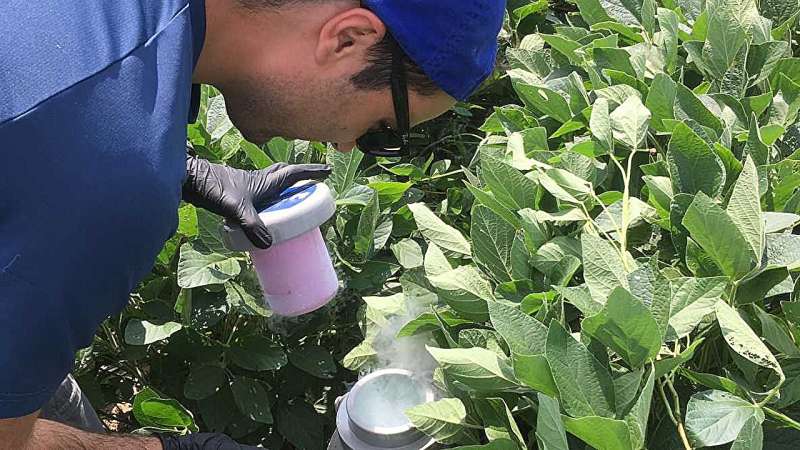This article has been reviewed according to Science X's editorial process and policies. Editors have highlighted the following attributes while ensuring the content's credibility:
fact-checked
trusted source
proofread
Field trials reveal crushed rock boosts carbon removal and improves crop yields

Crushed rock can remove about 3–4 metric tons of atmospheric carbon dioxide (CO2) per hectare per year and improve crop yields, results of a pioneering study have shown.
The four-year field trial in the U.S. Corn Belt, led by researchers at the University of Sheffield's Leverhulme Center for Climate Change Mitigation, shows adding crushed basalt to farmland in a process known as Enhanced Weathering, can also increase maize and soybean yields by 12%–16%.
Carbon removal strategies, like Enhanced Weathering (EW), alongside reducing emissions, have repeatedly been identified by the Intergovernmental Panel on Climate Change (IPCC) as necessary tools to minimize the worst impacts of climate change. Increasing crop yields are important for food security against continued global population growth and climate challenges.
The carbon removal approaches studied have the potential to not only remove significant quantities of carbon from the atmosphere and store it permanently, but to increase crop yields.
The study points to the substantial untapped potential for utilizing millions of hectares of U.S. farmland to scale Enhanced Weathering and deliver carbon dioxide removal with sustainable food and biofuel production. More than 39 million hectares of land in the U.S. alone are reserved for maize production, and more than 35 million hectares of soybeans were planted in the U.S. in 2021.
EW aims to accelerate natural weathering by spreading finely ground silicate rock (typically basalt, a common volcanic rock) onto soil, which speeds up chemical reactions between rocks, water, and air, while capturing carbon dioxide (CO2) from the atmosphere.
In the natural world, rocks such as basalt absorb CO2 as part of the continuous process of erosion over millions of years. This weathering process can be accelerated by crushing rocks to increase the reactive surface area and allow more CO2 to be absorbed. The dissolved CO2 is stored in soils or washed away into rivers and oceans where it is stored for hundreds of thousands of years.
The new study, published in the Proceedings of the National Academy of Sciences, found EW practices had substantial co-benefits to soil health and crop production as a result of increased nutrient availability with rising soil pH and greater nutrient supply released as the basalt minerals dissolve.
Genetic analysis of crop roots grown with basalt showed the genes responsible for nutrient acquisition from the soil responded to an increased uptake of mineral elements, supporting higher yields. Chemical analysis of the beans and grains also showed increased concentrations of micro and macro-nutrients, evidencing how enhanced weathering improved their nutritional status without any signals for potential health risks.
Maize is the second most widely grown crop in the world and this crop is used extensively for both bioenergy, animal feed and the human diet.
Lead author of the study, Professor David Beerling, Director of the Leverhulme Center for Climate Change and Mitigation at the University of Sheffield, said, "We have shown with hard-won data, the carbon removal potential of enhanced weathering practices in the real world. It's a big step forward in understanding the enormous potential of this technology to mitigate climate change while simultaneously improving yields and soil health."
Professor Noah Planavsky, a partner in the study from Yale University's Center for Natural Carbon Removal, said, "Carbon dioxide removal technologies need clear documentation of the CO2 removed and the effects of interventions—this case study shows that enhanced weathering can remove carbon and benefit American farmers."
Dr. Dimitar Epihov, a co-author of the study and Research Associate at the Leverhulme Center for Climate Change and Mitigation at the University of Sheffield, said, "We are excited to document the mechanisms underlying the crop yield increases with cutting-edge gene sequencing technology. By showing that crops growing with basalt re-programmed their root nutrient uptake gene networks, we advance our understanding of the connection between belowground processes and increases in crop production."
More information: David J. Beerling et al, Enhanced weathering in the US Corn Belt delivers carbon removal with agronomic benefits, Proceedings of the National Academy of Sciences (2024). DOI: 10.1073/pnas.2319436121
Provided by University of Sheffield


















